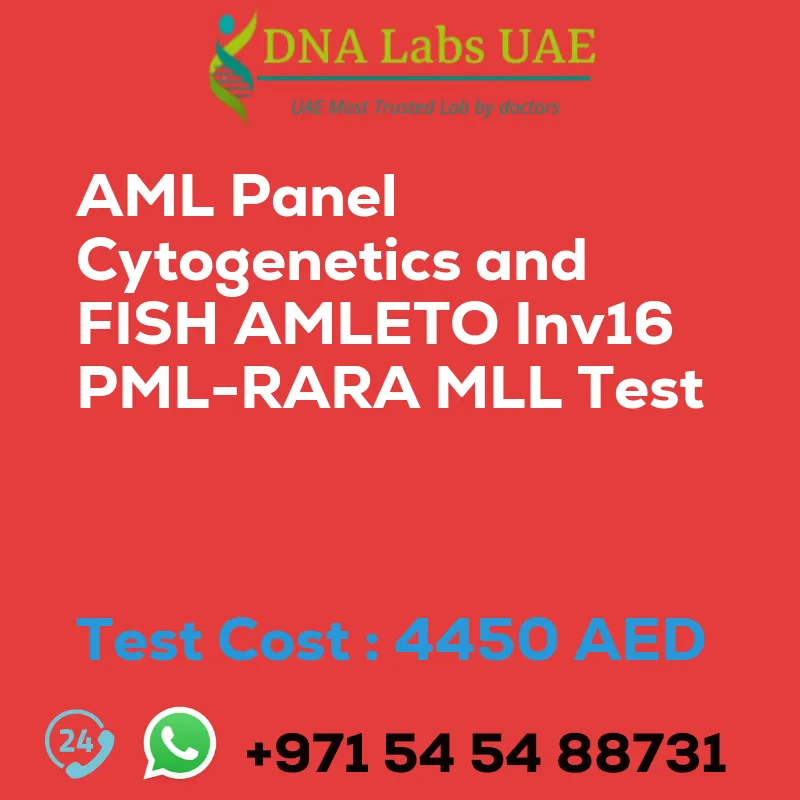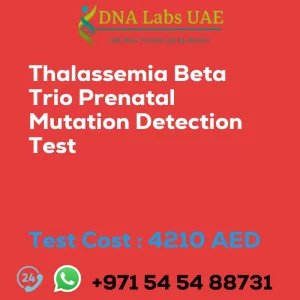AML PANEL Cytogenetics and FISH AMLETO inv16 PMLRARA MLL Test
Test Name: AML PANEL Cytogenetics and FISH AMLETO inv16 PMLRARA MLL Test
Components: Sodium Heparin Vacutainer (2ml)
Price: 4450.0 AED
Sample Condition: Bone marrow / Peripheral blood (Transport immediately)
Report Delivery: 5-7 days
Method: Cell Culture + FISH
Test type: Genetics
Doctor: Gynecologist
Test Department:
Pre Test Information: AML PANEL (Cytogenetics + FISH AML/ETO, inv(16), PML/RARA, MLL) can be done with a Doctors prescription. Prescription is not applicable for surgery and pregnancy cases or people planning to travel abroad.
Test Details
The AML panel typically includes cytogenetic analysis and fluorescence in situ hybridization (FISH) for specific genetic abnormalities associated with acute myeloid leukemia (AML). The panel includes testing for the following genetic abnormalities:
- AML/ETO: This FISH test detects the t(8;21) translocation, which results in the fusion of the AML1 and ETO genes. This translocation is associated with a subtype of AML called AML with t(8;21) (also known as AML-M2).
- inv(16): This FISH test detects the inversion of chromosome 16, which results in the formation of the CBFB-MYH11 fusion gene. This abnormality is associated with a subtype of AML called AML with inv(16) (also known as AML-M4Eo).
- PML/RARA: This FISH test detects the t(15;17) translocation, which results in the fusion of the PML and RARA genes. This translocation is associated with a subtype of AML called acute promyelocytic leukemia (APL) or AML-M3.
- MLL: This FISH test detects rearrangements involving the MLL gene (also known as KMT2A), which can occur through various translocations, insertions, or inversions. MLL rearrangements are associated with a subset of AML cases, particularly in infants and young children.
By analyzing these genetic abnormalities, the AML panel helps in the diagnosis, classification, and prognosis of AML patients. The results of the panel can guide treatment decisions, as some genetic abnormalities may have specific targeted therapies available.
| Test Name | AML PANEL Cytogenetics and FISH AMLETO inv16 PMLRARA MLL Test |
|---|---|
| Components | Sodium Heparin Vacutainer (2ml) |
| Price | 4450.0 AED |
| Sample Condition | Bone marrow \/ Peripheral blood (Transport immediately) |
| Report Delivery | 5-7 days |
| Method | Cell Culture + FISH |
| Test type | Genetics |
| Doctor | Gynecologist |
| Test Department: | |
| Pre Test Information | AML PANEL (Cytogenetics + FISH AML/ETO, inv(16), PML/RARA, MLL]) can be done with a Doctors prescription. Prescription is not applicable for surgery and pregnancy cases or people planing to travel abroad. |
| Test Details |
The AML panel typically includes cytogenetic analysis and fluorescence in situ hybridization (FISH) for specific genetic abnormalities associated with acute myeloid leukemia (AML). The panel includes testing for the following genetic abnormalities: 1. AML/ETO: This FISH test detects the t(8;21) translocation, which results in the fusion of the AML1 and ETO genes. This translocation is associated with a subtype of AML called AML with t(8;21) (also known as AML-M2). 2. inv(16): This FISH test detects the inversion of chromosome 16, which results in the formation of the CBFB-MYH11 fusion gene. This abnormality is associated with a subtype of AML called AML with inv(16) (also known as AML-M4Eo). 3. PML/RARA: This FISH test detects the t(15;17) translocation, which results in the fusion of the PML and RARA genes. This translocation is associated with a subtype of AML called acute promyelocytic leukemia (APL) or AML-M3. 4. MLL: This FISH test detects rearrangements involving the MLL gene (also known as KMT2A), which can occur through various translocations, insertions, or inversions. MLL rearrangements are associated with a subset of AML cases, particularly in infants and young children. By analyzing these genetic abnormalities, the AML panel helps in the diagnosis, classification, and prognosis of AML patients. The results of the panel can guide treatment decisions, as some genetic abnormalities may have specific targeted therapies available. |








